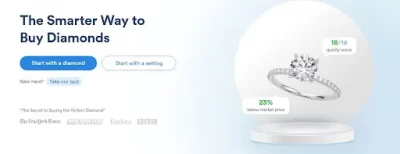If you’ve never shopped for diamonds, the terminology can quickly become confusing. To make sure that you get both a stone and a ring of the style and quality you want, it’s important to pay attention to the 4Cs of diamond classification: Cut, Color, Clarity, and Carat.

Clarity
Clarity refers to the cleanness within the stone. Both mined and lab-created gems can be of high clarity or show inclusions within the stone or blemishes on the surface. Inclusions in diamonds can actually add to the uniqueness of the gem, especially if the cut displays the inclusion in a specific way.
Inclusions in diamonds have started their own fashion trends. Salt and pepper diamonds have come in and out of favor over the years and feature black inclusions that cause the facets to reflect back dark areas inside the stone.
Clarity is also considered lacking when one can see fluorescence in diamonds. Fluorescence within a diamond causes the gem to reflect colored sparkles instead of uncolored flashes of light. Similar to the minerals that can cause inclusions within the stone, fluorescence can occur both in lab-created gems and diamonds mined from the earth.
Color
If you notice fluorescence in diamonds, it’s because the color is not entirely clear. Another material is embedded in the stone, causing it to take on a different color under a different light. How obvious is fluorescence in diamonds? Not every diamond that features fluorescence is obviously discolored; it may take a special light source to even bring out the new color.
However, a diamond that contains inclusions may be less obvious if the stone features many facets. The popular round-cut diamond is loaded with facets all across the face of the stone. Small inclusions may not even be visible to the eye. If you prefer a stone with a flat top, such as an Asscher or a cushion cut, any inclusions in diamonds will be magnified.
Cut
For those seeking a lot of sparkle, another option is the beautiful Princess cut. This cut was designed in the 1960s and features a lovely focus across the square top while offering plenty of flash and light. Be aware that this is a square-cut stone, which may stand a bit prouder than the wearer is accustomed to. A lovely option when designing your ring on Rare Carat is to choose a setting that wraps up and around the gem to increase security.
You can also be assured that your Princess cut ring will be unique. While Princess cut diamonds in bridal jewelry have been around for over 50 years, they are not as common as the round cut. Your Princess cut choice will offer the recipient a rare and unique gem to cherish.
Many are in the market for a diamond ring like the halo design. In this layout, a large center diamond is surrounded by smaller stones. To make sure that your ring is both beautiful and budget-friendly, you may find that a stone with fewer inclusions is a better choice for the center of the design. The smaller stones around that gem might actually add more to the ring if they reflect light a bit differently, adding to the unique features of the center stone.
Carat
The carat of a diamond refers to the weight and overall size. Whether you’re searching for a single stone or many small diamonds to adorn the ring you’re planning, you can have more flexibility in your ring budget if you choose some lab-created gems.
Lab-created gems were initially designed for industrial uses. The first stones were created as cutting tools. Over time, the engineers who created industrial diamonds were able to perfect gem-quality stones. However, lab-created gems are subject to many of the risks found in the crust of the earth.
You can find lab-created gems that fluoresce and contain inclusions. However, because the conditions in the lab are so much more reliable than those found deep in the earth, you have a chance of getting the stone you want with less risk. It should also be noted that diamond mining has led to a great deal of political upheaval and environmental devastation in the past. When you buy a lab-created diamond, you’re not contributing to that history.
No matter what stone qualities you choose, make sure you check out Rare Carat’s diamond marketplace. This company has a strong history of reputable activities, having 4.9/5 reviews on Trustpilot and Google Business.
















